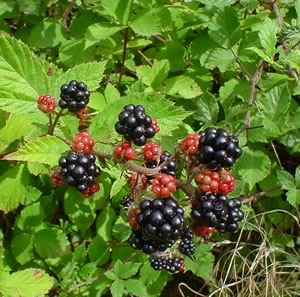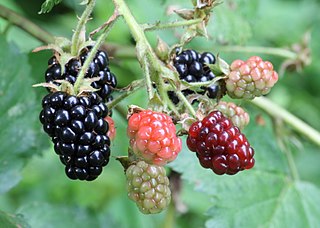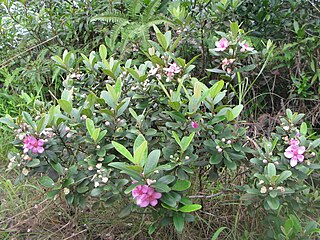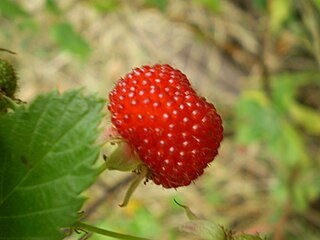
Rubus is a large and diverse genus of flowering plants in the rose family, Rosaceae, subfamily Rosoideae, with over 1,350 species, commonly known as brambles.

The blackberry is an edible fruit produced by many species in the genus Rubus in the family Rosaceae, hybrids among these species within the subgenus Rubus, and hybrids between the subgenera Rubus and Idaeobatus. The taxonomy of blackberries has historically been confused because of hybridization and apomixis, so that species have often been grouped together and called species aggregates. For example, the entire subgenus Rubus has been called the Rubus fruticosus aggregate, although the species R. fruticosus is considered a synonym of R. plicatus.

The raspberry is the edible fruit of a multitude of plant species in the genus Rubus of the rose family, most of which are in the subgenus Idaeobatus. The name also applies to these plants themselves. Raspberries are perennial with woody stems.

Rubus spectabilis, the salmonberry, is a species of bramble in the rose family Rosaceae, native to the west coast of North America from west-central Alaska to California, inland as far as Idaho. Like many other species in the genus Rubus, the salmonberry plant bears edible fruit, typically yellow-orange or red in color, resembling raspberries in appearance.

Rubus phoenicolasius is an Asian species of raspberry in the rose family, native to China, Japan, and Korea.

Rubus occidentalis is a species of Rubus native to eastern North America. Its common name black raspberry is shared with other closely related species. Other names occasionally used include bear's eye blackberry, black cap, black cap raspberry, and scotch cap.

Rubus parviflorus, commonly called thimbleberry, is a species of Rubus native to northern temperate regions of North America. The plant has large hairy leaves and no thorns. It bears edible red fruit similar in appearance to a raspberry, but shorter, almost hemispherical. It has not been commercially developed for the retail berry market, but is cultivated for landscapes.

Rubus leucodermis, also called whitebark raspberry or blackcap raspberry, is a species of Rubus native to western North America.

Rubus niveus is a species of Rubus. The native range of this scrambling shrub stretches from Afghanistan to central China, down to Java and Indo-China. It grows primarily in temperate regions.

Psidium cattleyanum , commonly known as Cattley guava, strawberry guava or cherry guava, is a small tree in the Myrtaceae (myrtle) family. The species is named in honour of English horticulturist William Cattley. Its genus name Psidium comes from the Latin psidion, or "armlet." The red-fruited variety, P. cattleyanum var. cattleyanum, is commonly known as purple guava, red cattley guava, red strawberry guava and red cherry guava. The yellow-fruited variety, P. cattleyanum var. littorale is variously known as yellow cattley guava, yellow strawberry guava, yellow cherry guava, lemon guava and in Hawaii as waiawī. Although P. cattleyanum has select economic uses, it is considered the most invasive plant in Hawaii.

Rhodomyrtus tomentosa also known as rose myrtle, is a flowering plant in the family Myrtaceae, native to southern and southeastern Asia, from India, east to southern China, Hong Kong, Taiwan and the Philippines, and south to Malaysia and Sulawesi. It grows in coasts, natural forest, riparian zones, wetlands, moist and wet forests, bog margins, from sea level up to 2400 m elevation.

Rubus hawaiensis, also called the ʻĀkala, is one of two species commonly known as Hawaiian raspberry, endemic to Hawaii. It is found on the islands of Kauaʻi, Molokaʻi, Maui, O'ahu, and Hawaiʻi in mesic to wet forest at elevations of 600–3,070 m (1,970–10,070 ft). In most areas it is not common, but in some places it can be a dominant member of the understory vegetation. Although superficially similar to the other Hawaiian species, Rubus macraei, the two are believed to be derived from separate dispersals to Hawaii.

Hosmer's Grove is an example of experimental forestation from Hawaii's territorial days. Located just inside Haleakala National Park near the summit of Haleakala in Maui, Hawaii, it includes a campsite and several hiking trails. The grove is well known amongst birdwatchers due to the abundance of endemic honeycreepers at the site, including Iiwi, Apapane, Hawaii Amakihi, and the Maui Alauahio.

Rubus armeniacus, the Himalayan blackberry or Armenian blackberry, is a species of Rubus in the blackberry group Rubus subgenus Rubus series Discolores Focke. It is native to Armenia and Northern Iran, and widely naturalised elsewhere. Both its scientific name and origin have been the subject of much confusion, with much of the literature referring to it as either Rubus procerus or Rubus discolor, and often mistakenly citing its origin as western European. Flora of North America, published in 2014, considers the taxonomy unsettled, and tentatively uses the older name Rubus bifrons.

Rubus probus, commonly known as Atherton raspberry or wild raspberry, is a scrambling shrub in the family Rosaceae native to Malesia and Queensland.

Rubus parvifolius, called Japanese bramble, or Australian raspberry in the United States or native raspberry in Australia is a species of plant in the rose family. It is a scrambling shrub native to eastern Asia and Australia. It has also become naturalized in a few scattered locations in the United States.

Rubus nepalensis, the Himalayan creeping bramble or Nepalese raspberry, is a species of evergreen raspberry endemic to Nepal and Himalayan India. It grows to about 1m in diameter, with height up to 20 cm. The fruit is small, edible, and slightly sour.

Rubus tricolor is an evergreen prostrate shrub, native to southwestern China. Leaves are dark green above, pale green below, and stems have red bristles. It has white flowers in summer and edible red fruit. It grows approximately 0.3 m (0.98 ft) high and usually forming a vigorously spreading, dense mat. In cultivation, it is mainly used as groundcover. Common names include Chinese bramble, groundcover bramble, creeping bramble, Korean raspberry, Himalayan bramble, and groundcover raspberry. In Chinese, it is called 三色莓.
Rubus dorcheae is a newly discovered Asian species of thorny fruiting shrub in Rosaceae family. It is native and endemic to Nepal, found only in the subtropical forests of Kathmandu. The samples of the new plant were collected for the first time from Shivapuri Nagarjun National Park in 2018 at an altitude of 1,930m. The taxon is named after plant enthusiast La Dorchee Sherpa who first came across the plant.























